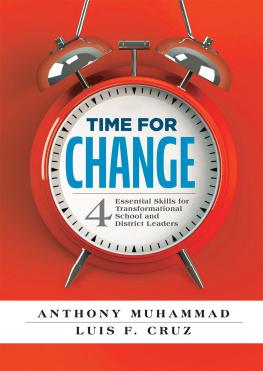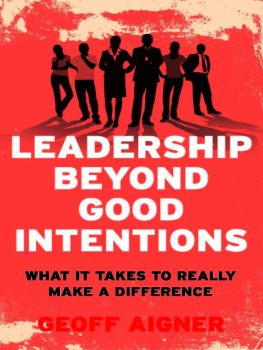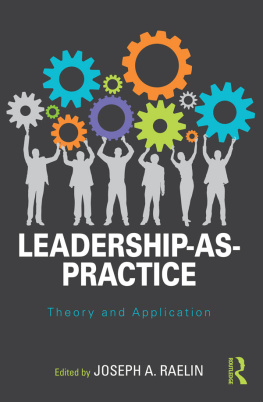
Copyright 2017 by John Wiley & Sons, Inc. All rights reserved.
Published by Jossey-Bass
A Wiley Brand
One Montgomery Street, Suite 1000, San Francisco, CA 941044594www.josseybass.com
No part of this publication may be reproduced, stored in a retrieval system, or transmitted in any form or by any means, electronic, mechanical, photocopying, recording, scanning, or otherwise, except as permitted under Section 107 or 108 of the 1976 United States Copyright Act, without either the prior written permission of the publisher, or authorization through payment of the appropriate per-copy fee to the Copyright Clearance Center, Inc., 222 Rosewood Drive, Danvers, MA 01923, 978-750-8400, fax 978-646-8600, or on the Web at www.copyright.com. Requests to the publisher for permission should be addressed to the Permissions Department, John Wiley & Sons, Inc., 111 River Street, Hoboken, NJ 07030, 201-748-6011, fax 201-748-6008, or online at www.wiley.com/go/permissions.
Limit of Liability/Disclaimer of Warranty: While the publisher and author have used their best efforts in preparing this book, they make no representations or warranties with respect to the accuracy or completeness of the contents of this book and specifically disclaim any implied warranties of merchantability or fitness for a particular purpose. No warranty may be created or extended by sales representatives or written sales materials. The advice and strategies contained herein may not be suitable for your situation. You should consult with a professional where appropriate. Neither the publisher nor author shall be liable for any loss of profit or any other commercial damages, including but not limited to special, incidental, consequential, or other damages. Readers should be aware that Internet Web sites offered as citations and/or sources for further information may have changed or disappeared between the time this was written and when it is read.
Jossey-Bass books and products are available through most bookstores. To contact Jossey-Bass directly call our Customer Care Department within the U.S. at 800-956-7739, outside the U.S. at 317-572-3986, or fax 317-572-4002.
Wiley publishes in a variety of print and electronic formats and by print-on-demand. Some material included with standard print versions of this book may not be included in e-books or in print-on-demand. If this book refers to media such as a CD or DVD that is not included in the version you purchased, you may download this material at http://booksupport.wiley.com. For more information about Wiley products, visit www.wiley.com.
Library of Congress Cataloging-in-Publication Data
Names: Komives, Susan R., 1946- author. | Wagner, Wendy (Wendy Elizabeth)
Title: Leadership for a better world : understanding the social change model of leadership development / Susan R. Komives, Wendy Wagner, and Associates.
Description: Second edition. | San Francisco, CA : Jossey-Bass, [2017] | Includes bibliographical references and index.
Identifiers: LCCN 2016029343 (print) | LCCN 2016031054 (ebook) | ISBN 9781119207597 (pbk.) | ISBN 9781119207603 (pdf) | ISBN 9781119207610 (epub)
Subjects: LCSH: Universities and collegesAdministration. | College administratorsProfessional relationships. | Educational leadership. | Social change.
Classification: LCC LB2341 .K66 2017 (print) | LCC LB2341 (ebook) | DDC 378.1/01dc23
LC record available at https://lccn.loc.gov/2016029343
Cover Design: Wiley
Cover Image: Ralf Hiemisch/Getty Images, Inc.
Dedicated to
Helen S. Astin
19322015
Activist, thinker, leader, scholar, friend
Cocreator of the Social Change Model of Leadership Development
Foreword
If you were to ask academics to list their most important learning goals for students, they would most likely include outcomes such as knowledge acquisition, the development of critical thinking skills, and the like. However, what most academics probably don't realize is that the student quality most frequently mentioned in the official mission statements of their colleges and universities is leadership.
The process that created the Social Change Model of Leadership Development (SCM) in many respects modeled the model. From the beginning it followed one of the basic precepts underlying the Social Change Model: that leadership is something carried out by a group rather than by an individual. Individuals can, of course, initiate. In fall 1993 my dear late wife and colleague Helen (Lena) Astin initiated the process when she dropped by my office to inform me that a young friend of ours, Goodwin Liu (another initiator), had brought to her attention a new federally funded program that might interest us. Known as the Dwight Eisenhower Leadership program, it provided funds for the creation of student leadership projects on college campuses. Because both Lena and I had previously conducted research on leadership, the project intrigued us. Our understanding of the leadership process suggested that what was really needed was a framework, or model, that could guide students in developing their leadership skills. We wanted the model to help instill in young persons a strong sense of social responsibility and a desire to become instruments of positive social change.
Because neither of us was particularly knowledgeable about matters relating to student leadership development, we naturally turned to the folks who do this for a living: student affairs practitioners. Most American college campuses are home to student affairs professionals who are deeply involved in the process of facilitating student leadership development, so we felt that the ideal model would be one that capitalized on the knowledge and experience of some of these experts. Lena and I started calling our friends in the student affairs field, including several who were or had been presidents of NASPA and ACPA, the field's two leading national professional associations, to identify individuals who were regarded as experts in student leadership development. The first few experts we contacted were also helpful in identifying additional colleagues to be recruited for the group that eventually came to call itself the working ensemble. Our ensemble comprised 15 individuals, including 8 leadership experts from the field of student affairs, 4 UCLA doctoral students, the Astins, and Carole Leland, Lena's coauthor of their landmark study of 77 women leaders, Women of Influence, Women of Vision. Carole had been working for the Center for Creative Leadership in North Carolina, and Lena was a member of the board of the center. Other members of the original ensemble included one of this book's editorsSusan R. Komivesand two of its chapter authors: Dennis C. Roberts and Marguerite Bonous-Hammarth.
Our ensemble held seven 2-day meetings over a period of more than a year with the aim of forging a preliminary version of a Social Change Model of Leadership Development. The notion of social change was embraced by the ensemble in recognition of two principles: (1) that leadership, as opposed to mere management, necessarily involves change and (2) that social change implies service to the others (i.e., Citizenship). Ensemble meetings, which were facilitated mainly by Lena, were lively and sometimes contentious, but nearly all participants remained focused on the goal of developing a workable model (Collaboration, Commitment, Common Purpose). To ensure that the ensemble could capitalize on the collective wisdom of the entire group, Lena actively encouraged each participant to be authentic and to share his or her viewpoints openly (Congruence).
By its third meeting our working ensemble had come to realize that the model had to be value-based, and to that end we began to create a list of basic values. Members would propose a particular value (e.g., Collaboration) to be added to the list, and we would all debate its pros and cons. One of the key considerations in these discussions was that the individual values be consistent, complementary, comprehensive, and nonredundant. Somewhat tongue-in-cheek, we labeled the preliminary list of values The Seven Cs.
Next page








